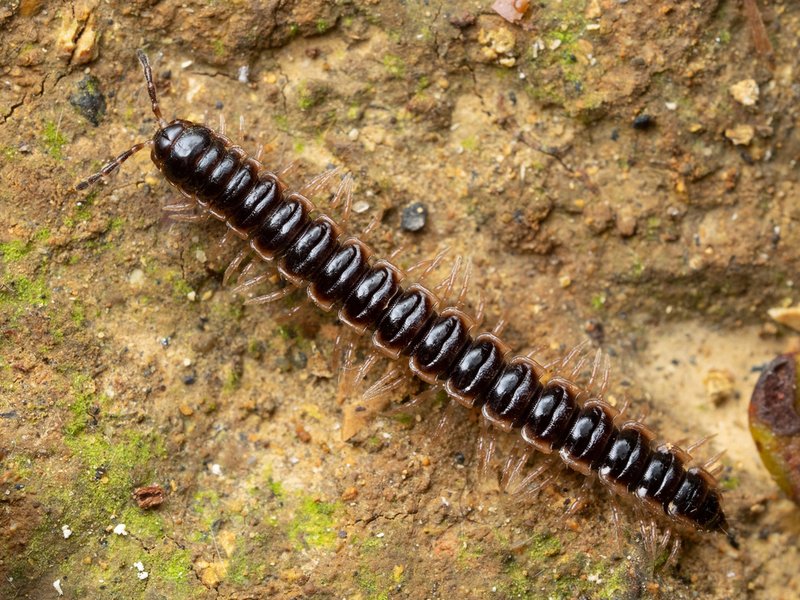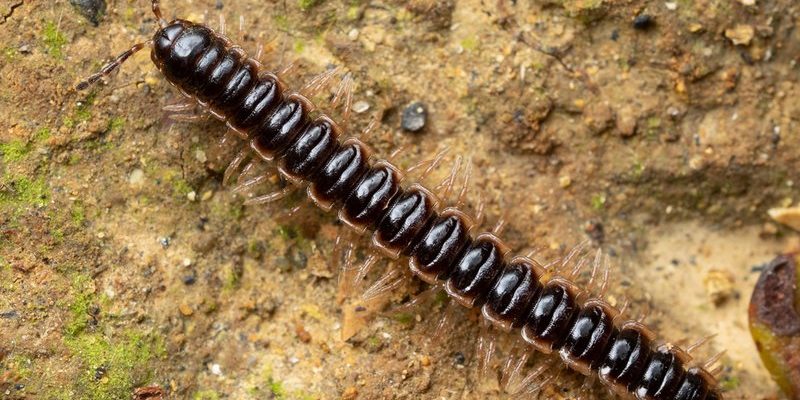
Imagine a tiny, wiggly creature that looks like it has a million legs! That’s the essence of a millipede. These fascinating arthropods belong to the class Diplopoda. While they don’t literally have a million legs—some species boast around 400 to 750 legs—they do have more than enough to make them one of the most distinctive critters in the animal kingdom. Known for their elongated bodies and numerous segments, millipedes may seem strange, but they play a vital role in our ecosystems.
You might be wondering what makes them different from their close relatives, the centipedes. Well, while centipedes are fast predators, millipedes are more like nature’s recyclers. They munch on decaying leaves and plants, turning them into rich soil. Isn’t it amazing how different creatures can have such different roles in their environment?
Millipedes have existed for millions of years, adapting to various environments from tropical rainforests to temperate woodlands. Their hard exoskeletons come in various colors and patterns, offering both a protective barrier and a camouflage against predators. In essence, they are more than just their many legs; they are part of a complex web of life that keeps our planet thriving.
Physical Characteristics
Millipedes have a distinctive appearance that sets them apart. Their bodies are made up of many segments—most have between 30 and 90 segments, and each segment typically has two pairs of legs. This unique structure is what gives them that characteristic look of having numerous legs. The most common species can grow from 2 to 12 inches long, but some can be much larger.
Let’s talk about their skin. The exoskeleton of a millipede is tough and helps protect them from predators. It’s made of chitin, which is the same material that makes up the shells of crustaceans. Some species can even secrete a liquid that has a noxious odor to deter animals that might want to eat them. Think of it as their own little defense mechanism!
In terms of coloration, millipedes can be quite beautiful. While many are a dull brown or black to blend in with the forest floor, some species sport vibrant colors or patterns that can serve as a warning to predators. This is nature’s way of saying, “Hey, I’m not a snack!”
Habitat and Distribution
Millipedes are found all over the world, but they prefer humid environments. You’ll often find them in leaf litter, under logs, or within the soil. Since they thrive in moisture, tropical rainforests offer an ideal habitat, but you can also spot them in temperate forests, grasslands, and even deserts.
These creatures play an essential role in breaking down organic matter. By decomposing dead plants and leaves, they enrich the soil, making it more fertile for new life to sprout. Isn’t it fascinating how such tiny creatures can significantly impact their environment?
Some species even have specific home ranges, while others can be more migratory, seeking out moist areas when their current habitat becomes too dry. This adaptability is part of what has allowed millipedes to thrive in various climates and conditions throughout their long evolutionary history.
Diet and Feeding Habits
Millipedes are primarily detritivores, meaning they feed on decaying organic material. Their diet mainly consists of dead leaves, plant debris, and even wood. You might think that sounds boring, but it’s crucial for the ecosystem. As they consume organic matter, they break it down into smaller pieces, making it easier for other decomposers like fungi and bacteria to do their work.
What’s particularly interesting is their feeding strategy. Millipedes use specialized mouthparts to chew their food thoroughly before swallowing it. This chewing process is vital as it allows them to extract the necessary nutrients from their meals. In a way, they are nature’s little recyclers, turning what would otherwise be waste back into the earth.
They can also have a higher capacity to process plant fibers than some other decomposers, meaning they can help speed up the decomposition process. In doing so, they contribute to soil health and nutrient cycling, which supports plant growth, animal life, and overall ecosystem balance.
Life Cycle and Reproduction
Millipedes have a fascinating life cycle. They begin their journey as tiny eggs, which the female lays in moist soil or decomposing organic matter. After several weeks, these eggs hatch into young millipedes that resemble miniature adults but lack fully developed legs. As they grow, they molt several times, shedding their exoskeleton to accommodate their expanding bodies.
Diversity exists in their reproductive habits. Some millipedes are capable of parthenogenesis, which means they can reproduce without mating, producing offspring that are genetic clones of themselves. In other species, males perform intricate courtship displays to attract females, making the process quite charming.
Interestingly, millipedes continue to add body segments throughout their life. Unlike centipedes, which have a fixed number of body segments, millipedes can keep growing, adding segments and legs as they age. This ability allows them to adapt to their environments more efficiently as they progress through their life stages.
Threats and Conservation
While many millipede species thrive, they still face threats from habitat loss, pollution, and climate change. Deforestation and urbanization can significantly reduce their habitats, making it harder for them to find the moisture they need to survive. Additionally, pesticides and chemicals in agriculture can harm their populations.
Conservation efforts are essential in protecting these intriguing creatures and their ecosystems. By maintaining healthy ecosystems and promoting sustainable practices, we can help ensure that millipedes continue to thrive in the wild. Every little step counts!
Public awareness is also vital in conservation. Understanding the role of millipedes in the ecosystem can lead to more respect and care for their habitats. After all, when we protect the smallest creatures, we bolster the health of the planet as a whole.
Interesting Facts About Millipedes
| Size: | Typically 2 to 12 inches long |
| Habitat: | Tropical and temperate forests, grasslands, and humid regions |
| Diet: | Decaying plant material and organic matter |
| Lifespan: | Up to 10 years, depending on the species |
| Legs: | 30 to 750 legs, depending on the species |
| Defense Mechanism: | Secrete noxious fluid to deter predators |
Millipedes in Culture and Folklore
Millipedes have captured human imagination for centuries. In various cultures, they are often seen as symbols of protection and resilience. Some indigenous groups have even regarded them as protectors of the soil and facilitators of growth. Their role in nature resonates through stories and teachings, helping people appreciate the interconnectedness of life.
In folklore, millipedes have sometimes been associated with transformation or change due to their ability to regenerate after losing legs. They symbolize adaptability, demonstrating how even the smallest creatures can overcome challenges. This perspective invites us to view these tiny beings in a new light, as significant players in our ecosystem.
Furthermore, in some cultures, millipedes have found their way into traditional medicine. Certain species are believed to have healing properties, although scientific backing is limited. Regardless, the respect for these creatures reflects humanity’s connection to the natural world and our desire to learn from it.
Millipedes may be small, but they play a massive role in maintaining the health of our ecosystems. From their unique physical characteristics to their fascinating life cycles, these creatures offer a glimpse into the complex web of life that exists right beneath our feet. By learning more about them, we can appreciate their contributions to nature and the importance of protecting their habitats.
The next time you stumble upon a millipede, remember that you’re witnessing a tiny part of a much larger story. They are not just a wiggly mass of legs; they are essential allies in the cycle of life. So, let’s give these little recyclers the respect they deserve!
FAQ
Are millipedes harmful to humans?
Millipedes are generally harmless to humans. They don’t bite or sting, but some species can secrete a liquid that may irritate the skin. If you encounter one, it’s best to observe from a distance.
How do millipedes breathe?
Millipedes breathe through small openings called spiracles, located along the sides of their bodies. The oxygen enters through these openings and is distributed through their bodies via a system of tubes known as tracheae.
Can millipedes regenerate lost legs?
Millipedes can regenerate lost legs, but this ability varies among species. Typically, if a millipede loses a leg during an encounter with a predator, it can regrow it after several molts.
What do baby millipedes look like?
Baby millipedes, or juveniles, look like miniature adults but have fewer legs. They gradually develop more segments and legs as they grow and molt.
How long do millipedes live?
Most millipedes live up to 5-10 years, depending on the species and environmental conditions. They grow slowly, so their lifespan can vary significantly.
Where do millipedes go during winter?
During winter, many millipedes seek shelter in the soil or under leaf litter to escape the cold. They can enter a dormant state, reducing their activity until warmer temperatures return.
Do millipedes have any natural predators?
Yes, millipedes have a variety of natural predators including birds, mammals, and some insects. Their ability to secrete noxious chemicals helps deter some of these threats.
How do you identify different species of millipedes?
Identifying millipede species can be tricky as they can vary in size, color, and number of segments. Observing specific markings, body shape, and habitat can aid in identification.
Can millipedes be kept as pets?
Yes, some people keep specific species of millipedes as pets. They require a suitable habitat with humidity, soil, and decaying plant matter for food. Researching their needs can help ensure a proper care environment.
What are some common misconceptions about millipedes?
Many people think all millipedes are dangerous, but that’s not true. They’re mostly harmless and beneficial for the environment. Another misconception is that they can have a million legs—most only have a few hundred!
How do millipedes contribute to the ecosystem?
Millipedes play a crucial role in decomposition. By breaking down decaying plant material, they recycle nutrients back into the soil, supporting plant growth and overall ecosystem health.
Where can I find millipedes?
Millipedes are commonly found in moist environments such as forests, gardens, and under logs. They thrive in leaf litter or soil where humidity is higher, making these areas ideal for spotting them.
What is the difference between millipedes and centipedes?
Millipedes have two pairs of legs per body segment and are mainly decomposers, while centipedes have one pair and are predators that hunt other insects. Additionally, millipedes generally move slowly, whereas centipedes are faster and more aggressive.
Can I handle a millipede?
While you technically can handle a millipede, it’s best to do so with care. They may secrete a liquid that can irritate your skin. If you find one, it’s safer to admire it from afar or gently observe it in its natural habitat.

